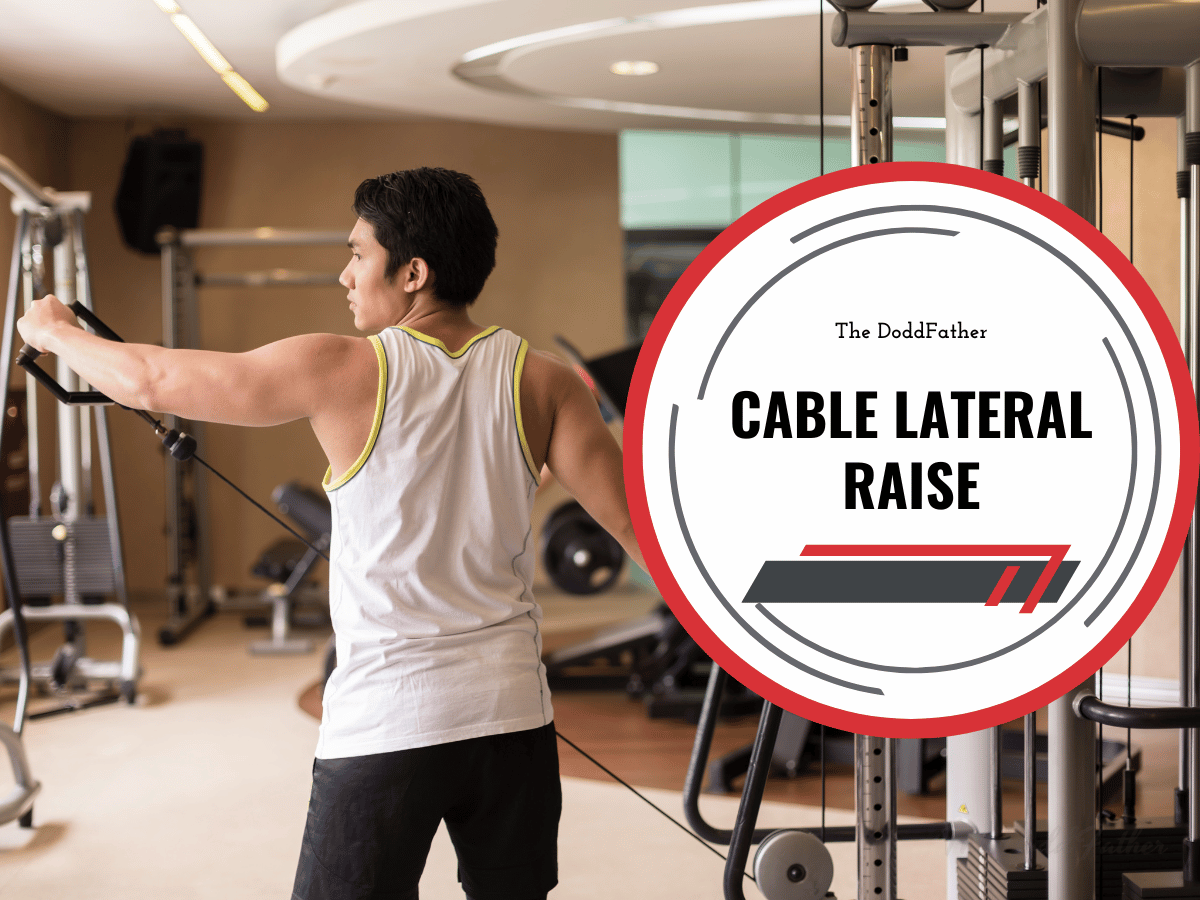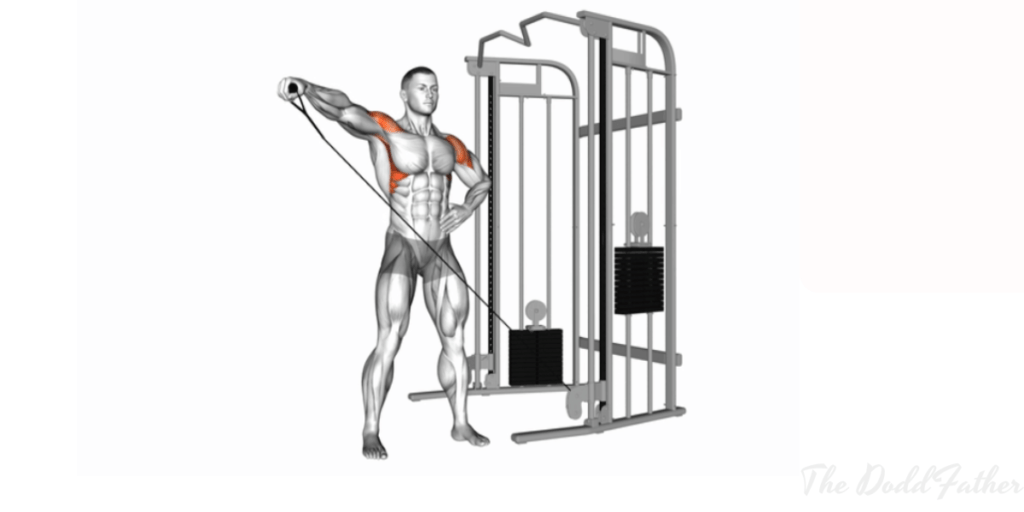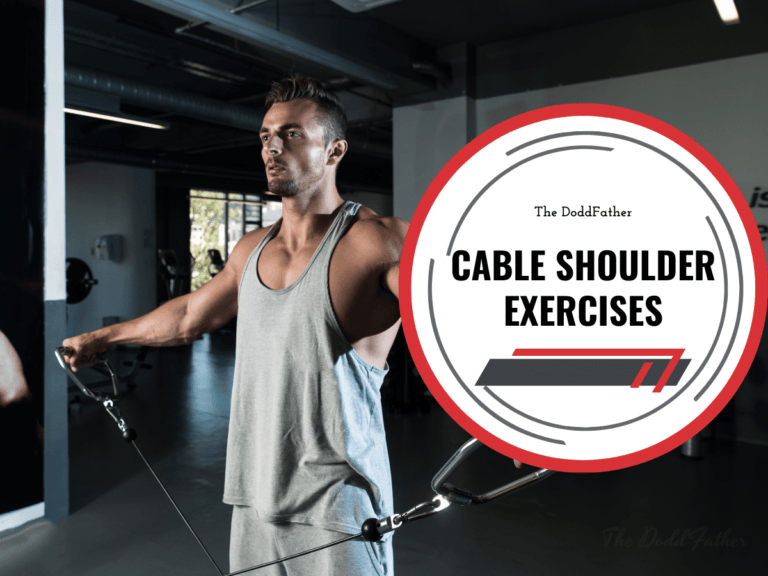
Cody Dodd is a NASM-certified personal trainer and Navy Command Fitness Leader who uses his fitness expertise to write fitness content for The DoddFather. Cody has transformed his physique and confidence by understanding the principles of exercise and fitness.
It all started with a radical fat loss of 55 pounds. From 225 to 170. From a kid who once couldn’t do a pull up, to knocking out 20 pullups in a Navy command competition while floating in the middle of the ocean.
He has a diverse writing and editing background that’s primarily focused on health and fitness, Navy life, and dad life. His work has been featured in Good Dads, as well as Platform Launchers, and Daddying.
Let’s be honest – who doesn’t want shoulders that command attention? The kind that fill out a t-shirt and exude confidence?
Well, I’m here to tell you that the cable lateral raise is your golden ticket to achieving those dream delts. This exercise might seem simple, but it packs a powerful punch when it comes to isolating and strengthening your lateral deltoid muscles – the key to that coveted shoulder width.
According to Strength Level, the 1RM for the average male lifter on a cable lateral raise is 40 pounds. For beginners, that 1RM comes out to just 2 pounds. Your initial instinct might be to scoff at 2 pounds, but that can be incredibly challenging if your form is dialed in!
We all start somewhere. So, grab those handles, and let’s dive into the world of cable lateral raises!
Mastering the Cable Lateral Raise Technique
I remember when I first tried cable lateral raises; I thought, “How hard can it be? Just lift the weights out to the sides, right?” I would look at the people doing 5 pounds and think about how I could easily do 20 pounds. These were grown adults lifting 5 pounds! I would surely show them up.
But the thing is, they were utilizing good form. Sure I could move 20 pounds on a cable lateral raise, but I’m pretty sure it was working every muscle in my body. If you don’t feel like the prime mover is being effectively worked in an isolation exercise, your form is lacking and the weight is probably too heavy.
Movement Walkthrough
- Adjust the cable pulley to the lowest setting.
- Grab the handles with a neutral grip (palms facing each other).
- Stand with your feet shoulder-width apart, core engaged, and a slight bend in your knees.
- Keeping your elbows slightly bent and your wrists straight, slowly raise the cables out to the sides until your arms are parallel to the floor.
- Pause at the top, squeezing your delts.
- Slowly lower the weights back to the starting position with control.
Form Mistakes
- Using too much weight: This leads to swinging the torso, risking back pain instead of targeting the shoulders.
- Bending your wrists: Maintain firm and straight wrists to prevent unnecessary stress on the joints.
Breathing Practice
Inhale as you lower the weights, and exhale as you raise them. It might sound simple, but proper breathing helps stabilize your core and generate more power. And don’t forget to brace your core! Think of it as creating a solid foundation for your upper body to move from.
Mastering the cable lateral raise technique takes time and practice, but trust me, it’s worth it. Once you nail the form, you’ll be well on your way to sculpting those dream shoulders.
Variations to Spice Up Your Shoulder Workout
First up, we have the unilateral vs. bilateral debate. Unilateral cable lateral raises (one arm at a time) are fantastic for addressing any strength imbalances between your left and right sides. Plus, they force your core to work overtime to stabilize your body.

On the other hand, bilateral cable lateral raises (both arms simultaneously) allow you to lift heavier weight and really blast those delts. Personally, I like to mix it up, incorporating both variations into my routine.

But hey, maybe you’re feeling adventurous and want to try something completely different. No problem! There are plenty of cable lateral raise alternatives out there to keep your workouts fresh and exciting.
You could try dumbbell lateral raises, leaning away lateral raises, band lateral raises, or even machine lateral raises. Each variation offers its own unique benefits, so don’t be afraid to experiment and find what works best for you.
The key is to challenge your muscles in new and different ways. By incorporating variations and alternatives into your routine, you’ll keep those shoulders growing and prevent plateaus. So, go ahead, get creative, and have some fun with it!
Integrating Cable Lateral Raises into Your Routine
Let’s talk about how to seamlessly integrate cable lateral raises into your workout routine.
First up we have sets, reps, and weight. Generally, I recommend aiming for 3-4 sets of 8-12 reps per side. As for weight, choose a weight that challenges you but allows you to maintain proper form throughout all reps. It’s always better to start lighter and gradually increase the weight as you get stronger than to go too heavy and risk injury.
Now, where should you slot cable lateral raises into your workout? I like to include them towards the beginning of my shoulder routine, after a few warm-up sets. This way, my shoulders are fresh and ready to fire on all cylinders. But hey, you can experiment and find what works best for you.
Here’s a sample shoulder workout incorporating cable lateral raises that you can try:
- Warm-up:
- Light cardio (5 minutes)
- Dynamic stretches (5 minutes)
- Workout:
- Overhead press (3 sets of 6-8 reps)
- Cable lateral raises (3 sets of 10-12 reps per side)
- Seated dumbbell shoulder press (3 sets of 8-10 reps)
- Bent-over dumbbell lateral raises (3 sets of 10-12 reps)
- Front raises (3 sets of 10-12 reps)
- Cool-down: Static stretches (5-10 minutes)
Progression is key to continued growth. As you get stronger, gradually increase the weight you’re lifting or the number of reps you’re performing. You can also try incorporating more advanced variations or increasing the frequency of your shoulder workouts.
The most important thing is to listen to your body and adjust your routine as needed. If you’re feeling pain, stop and rest. And don’t be afraid to ask a qualified trainer for help if you’re unsure about anything.
Benefits of Cable Lateral Raises Beyond Aesthetics
Alright, let’s be real for a second. We all want to look good, and there’s no shame in that. But cable lateral raises offer so much more than just aesthetic benefits. They’re like the Swiss Army knife of shoulder exercises, providing a whole host of functional advantages that can improve your overall quality of life.
Cable lateral raises help improve shoulder stability and function. Think about it – your shoulders are involved in almost every upper body movement you perform, from reaching for a cup on the top shelf to throwing a ball to your dog. By strengthening your lateral deltoids, you’re essentially building a more stable foundation for your shoulder joint, which can translate to better performance in everyday activities and sports.
But wait, there’s more! Cable lateral raises can also play a crucial role in injury prevention and rehabilitation.
I’ve personally dealt with my fair share of shoulder pain over the years, and I can tell you firsthand that strengthening the muscles surrounding the shoulder joint is key to keeping those pesky injuries at bay. And if you’ve already experienced a shoulder injury, cable lateral raises can be a valuable tool in your rehabilitation program, helping you regain strength and range of motion.
Beyond the physical benefits, I’ve also found that cable lateral raises can have a positive impact on my mental well-being. There’s something incredibly empowering about feeling strong and capable in my own body. Plus, the sense of accomplishment I get from pushing myself and seeing progress in the gym is truly priceless.
So, next time you’re hitting the gym, don’t just think of cable lateral raises as a way to build bigger shoulders. Think of them as an investment in your overall health and well-being. Your body will thank you for it!
Conclusion
The cable lateral raise is a fantastic exercise for sculpting those head-turning shoulders. By mastering proper form, incorporating variations, and strategically integrating this exercise into your routine, you’ll be well on your way to achieving your shoulder goals.
Consistency is key! Keep pushing yourself, and those delts will be thanking you in no time. Now go hit the gym and show those cables who’s boss!





